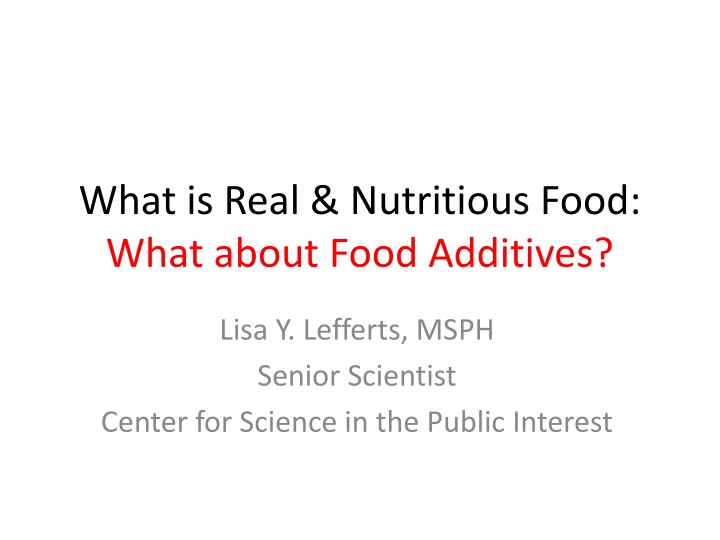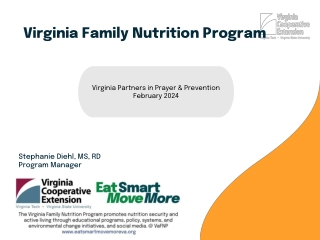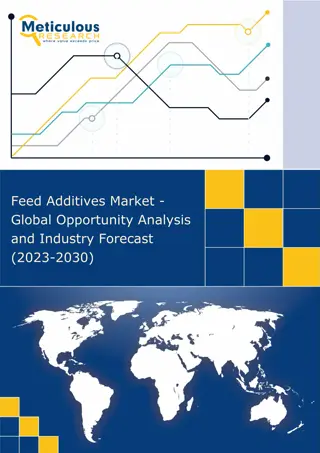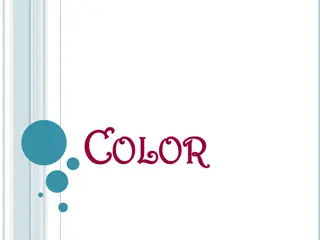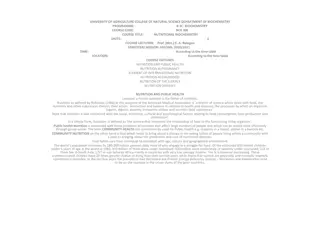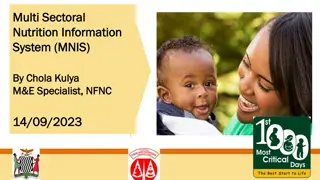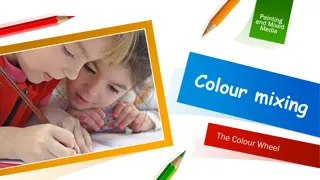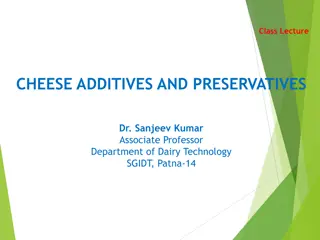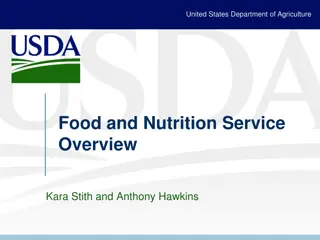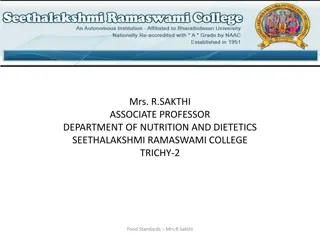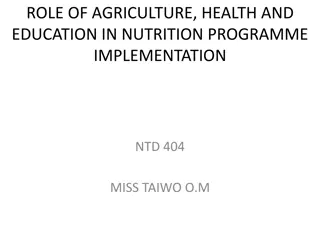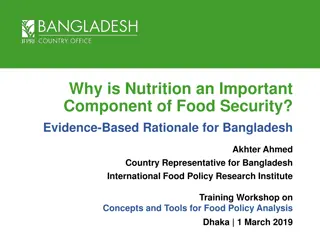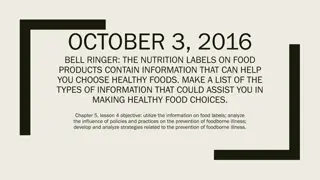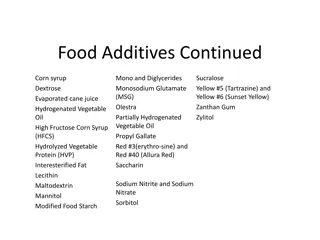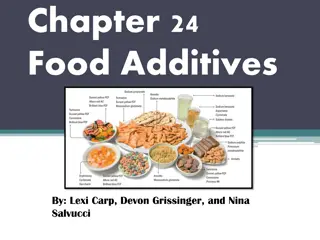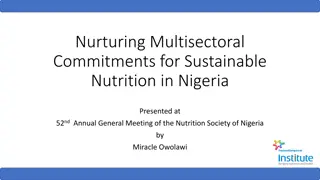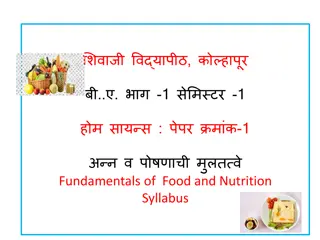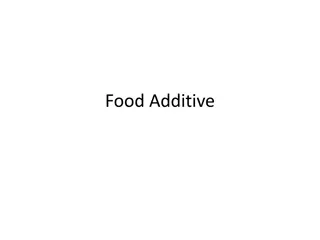Unveiling the Risks of Food Additives and Artificial Colors in Nutrition
Exploring the impact of food additives and artificial colors on nutrition, this content sheds light on the risks associated with their consumption. From artificial colors like Red 40 and Yellow 6 to the behavioral implications in susceptible children, the data presented unveils the potential adverse effects on health linked to these substances. Discover insights on how these additives can mask nutritional deficiencies, displace natural colors, and potentially exacerbate conditions like ADHD. Understand the concerning findings revealed by the FDA in 2010 regarding the behavioral effects of artificial food colors, highlighting the importance of awareness and informed choices in food consumption.
Download Presentation

Please find below an Image/Link to download the presentation.
The content on the website is provided AS IS for your information and personal use only. It may not be sold, licensed, or shared on other websites without obtaining consent from the author.If you encounter any issues during the download, it is possible that the publisher has removed the file from their server.
You are allowed to download the files provided on this website for personal or commercial use, subject to the condition that they are used lawfully. All files are the property of their respective owners.
The content on the website is provided AS IS for your information and personal use only. It may not be sold, licensed, or shared on other websites without obtaining consent from the author.
E N D
Presentation Transcript
What is Real & Nutritious Food: What about Food Additives? Lisa Y. Lefferts, MSPH Senior Scientist Center for Science in the Public Interest
What is Real & Nutritious Food? Nutrition Food Safety Additives
Food Dyes Cosmetic, Not Nutritional/Health Function Mask Absence of/Displace Colorful Fruits & Vegetables Behavioral, cancer, allergy concerns
Where are the Cherries & Berries in Tropicana Twister Cherry Berry Blast? Ingredients: Filtered Water, High Fructose Corn Syrup, Apple and Grape Juice Concentrates, Citric Acid, Natural and Artificial Flavors, Ascorbic Acid (Vitamin C) and Red 40. Contains 10% Juice. Answer: on the label (not in the bottle)
Rainbow Grab-n-Go Salads from Kalispell Public Schools in Montana
Artificial Coloring Red 40, Yellow 6, Blue 1 Red 40, Blue 1, Blue 2, Yellow 6, Turmeric, Annatto Caramel Coloring
Risks of Food Colors: Behavior for certain susceptible children with ADHD and other problem behaviors, the data suggest that their condition may be exacerbated by exposure to a number of substances in food, including, but not limited to, artificial food colors. FDA, 2010
Risks of Food Colors: Behavior Exposure to food and food components, including artificial food colors and preservatives, may be associated with adverse behaviors, not necessarily related to hyperactivity, in certain susceptible children with ADHD and other problem behaviors, and possibly in susceptible children from the general population. -- FDA, 2010
Risks of Food Colors: Behavior If a child shows signs of hyperactivity or Attention Deficit Hyperactivity Disorder (ADHD), eliminating the colours* considered in the Southampton study from their diet might have some beneficial effects on their behavior. - UK Food Standards Agency * Includes Yellow 5, Yellow 6, Red 40
Risks of Food Colors: Behavior The label may have an adverse effect on activity and attention in children is required in Europe on foods containing any of the Southampton colors (includes Yellow 5, Yellow 6, and Red 40).
Other Risks of Food Colors Cancer Red 3, Yellow 5, Yellow 6, Red 40, Caramel Red 3 carcinogenic, banned from cosmetics, externally applied drugs, and lakes Yellow 5, Yellow 6 benzidine, 4-amino-biphenyl (US ROC: known to be a human carcinogen ) Red 40 p-cresidine (US ROC: reasonably anticipated to be a human carcinogen ) Caramel (ammoniated) 4-methyl-imidazole (IARC: possibly carcinogenic to humans Allergic reactions Blue 1, Red 40, Yellow 5, Yellow 6; annatto, cochineal
Food Colorings Solutions Ban dyes that cause cancer and adverse behavioral impacts Require warning notices for dyes that impact behavior, as the EU has done Require front label disclosure of any added coloring Press companies not to use artificial colorings
Caffeine The only drug that is present naturally or added to widely consumed foods Should a mildly addictive stimulant drug be permitted at school? (photo credit: Mararie/flickr)
Caffeine FDA states Caffeine is a central nervous system stimulant, and Some studies show that caffeine causes a physical dependence or addiction. http://www.fda.gov/downloads/drugs/resourcesforyou/consum ers/buyingusingmedicinesafely/understandingover-the- countermedicines/ucm205286.pdf
American Academy of Pediatrics on Caffeine Rigorous review and analysis of the literature reveal that caffeine and other stimulant substances contained in energy drinks have no place in the diet of children and adolescents. -- Pediatrics 2011;127:1182 1189
Caffeine: Institute of Medicine Nutrition Standards for Foods in Schools (2007) the committee did not support offering products containing significant amounts of caffeine for school-age children because of the potential for adverse effects, including physical dependency and withdrawal . Thus the committee judged that caffeine in significant quantities has no place in foods and beverages offered in schools.
Caffeine at School Several states do not allow caffeinated beverages in schools, including: California Hawaii New Mexico Vermont Many caffeine-free low calorie beverages are available on the market. Connecticut Massachusetts Rhode Island localities in Utah, etc.
Caffeine: Breaking Boundaries Traditional sources: Coffee, tea, soda, cocoa Medicines: headache remedies, cough/cold medications, weight-reduction products New foods: chips, popcorn, waffles, ice cream, syrup, oatmeal, granola, candy, trail mix New beverages: bottled water, energy drinks Other New Products: sprays, lotions, lip balm, patches, shampoos
FDA Investigation of Caffeinated Products Our concern is about caffeine appearing in a range of new products, including ones that may be attractive and readily available to children and adolescents, without careful consideration of their cumulativeimpact. The proliferation of these products in the marketplace is very disturbing to us. -- FDA Deputy Commissioner Michael R. Taylor, May 2013
Caffeine and ER Visits ER visits due to energy drinks have increased over 13-fold between 2005 and 2011, with 1,499 visits reported in children aged 12 to 17 in 2011. -- US Substance Abuse and Mental Health Services Administration, The Dawn Report (2013)
Caffeine in Coffee: Breaking Boundaries Starbucks: 330 mg/16 ounce cup (415 mg/20-ounce cup) FDA (2007): 100 mg/5 ounce cup
Caffeine Levels Caffeine Intoxication (DSM-5): can occur with low doses (e.g., 200 mg) in vulnerable individuals such as children, the elderly, or individuals who have not been exposed to caffeine previously. Canadian recommended limit for children under 12: 2.5 mg/kg (e.g., 85 mg for children 10-12) FDA official limit for cola and pepper soft drinks: 71 mg per 12- ounce serving (200 ppm)
Caffeine - Solutions Caffeine, a mildly addictive stimulant, is not appropriate for consumption by children and adolescents (AAP) Caffeinated products should not be sold in schools, including high schools (IOM) Caffeine content should be required to be listed on the label FDA should act to limit the proliferation of caffeine-added products in the marketplace.
Other Food Additives of Concern Reasonably Anticipated to be a Human Carcinogen : BHA (a preservative) Methyleugenol and acetaldehyde (flavoring agents)
Other Food Additives of Concern Clear evidence of carcinogenic activity : Aloe vera (ingested) Ginkgo biloba
Other Food Additives of Concern Having concluded that FD+C Red No. 3 causes cancer in rats, the agency hereby terminates the provisional listing of FD+C Red No. 3 for use in cosmetics and externally applied drugs and the provisional listing of the lakes of FD+C Red No. 3 for use in food, drug, and cosmetic products (21 CRF81.10) Red 3 is still used in candy, fruit roll-ups, and baked goods
Other Food Additives of Concern Aspartame: Caused cancers at multiple sites in 3 independent animal studies CSPI has carefully reviewed these studies and evaluations of the laboratory conducting them These studies are more powerful and more reliable than earlier, industry-sponsored studies
Which food additives are safe and which are not? See http://www.cspinet.org/reports/chemcuisine.htm
